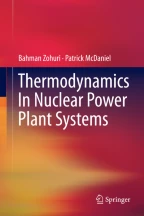
A pure substance is a material with a constant chemical composition throughout its entire mass. A pure substance can exist in one or more physical phases such as a solid, liquid or vapor. Each phase will have homogeneous physical characteristics, but all three phases could be different physical forms of the same pure substance. The temperature and pressure boundaries between phases are well defined and it usually requires an input or extraction of thermal energy to change from one phase to another. Most pure substances have a well defined Triple Point where all three phases exist in equilibrium.
This chapter deals with the relationship between pressure, specific volume, and temperature for a pure substance.
This is a preview of subscription content, log in via an institution to check access.
eBook EUR 139.09 Price includes VAT (France)
Softcover Book EUR 177.46 Price includes VAT (France)
Tax calculation will be finalised at checkout
Purchases are for personal use only
Problem 2.1: It is necessary to store one kmol of Methane at 300 °K and 60 MPa. Determine the volume of the cylinder that is required for storage by each of the following:
Problem 2.2: One kmol of Ethylene is contained in a 0.6 m 3 steel vessel immersed in a constant temperature bath at 200 °C. Calculate the pressure developed by the gas by each of the following:
Problem 2.3: Expand the following equations in the form
and determine the second virial coefficient B in each case:
$$\left( P+\frac<<<\upsilon >^>> \right)(\upsilon -b)=RT\text< (van der Waals equation of state)>\text$$ $$\left( P<^> \right)(\upsilon -b)=RT\text< (Dieterici equation of state)>\text$$^>T> \right)(\upsilon -b)=RT\text< (Clausius equation of state)>$$ $$P\upsilon =RT\left( 1+\fracProblem 2.4: Two gram-moles of nitrogen is placed in a three-liter tank at − 150.8 °C. Estimate the tank pressure using the ideal gas equation of state and then using the virial equation of state truncated (Eq. 2.27) after the second term. Taking the second estimate to be correct, calculate the percentage error that results from the use of the ideal gas equation at the system conditions.
Problem 2.5: A gas cylinder with a volume of 2.50 m 3 contains 1.00 kmol of carbon dioxide at \(T=300<>^\circ \text\) . Use the Peng-Robinson equation of state to estimate the gas pressure in atm.
Problem 2.6: A rigid tank contains 20 lbm of air at 20 psia and 70 °F. More air is added to the tank until the pressure and temperature rise to 35 psia and 90 °F, respectively. Determine the mass of air added to the tank.
Problem 2.7: A perfectly fitting pot and its lid often stick after cooking, and it becomes very difficult to open the lid when the pot cools down. Explain why this happens and what you would do to open the lid.
Problem 2.8: Estimate the error in using the Ideal Gas law to calculate the specific volume of nitrogen at 20 Mpa and 300 K. Use either the Van der Waals or the Redlich-Kwong real gas models for the more correct answer.
© 2015 Springer International Publishing Switzerland
Zohuri, B., McDaniel, P. (2015). Properties of Pure Substances. In: Thermodynamics In Nuclear Power Plant Systems. Springer, Cham. https://doi.org/10.1007/978-3-319-13419-2_2
Anyone you share the following link with will be able to read this content:
Get shareable link
Sorry, a shareable link is not currently available for this article.
Copy to clipboard
Provided by the Springer Nature SharedIt content-sharing initiative